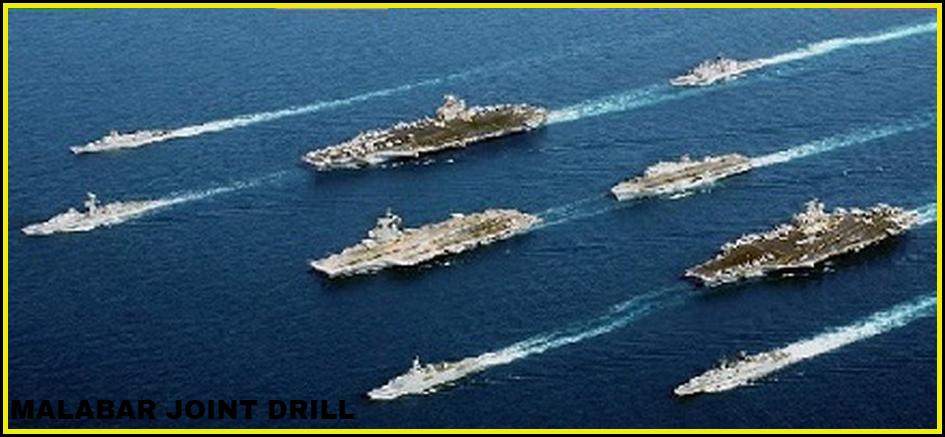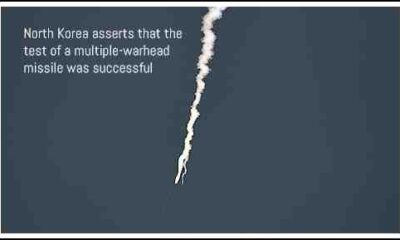ANTI-SUBMARINE WAREFARE
Malabar Joint Drills with a Focus on Anti-Submarine Warfare to Be Started by Quad Navies
Published
11 months agoon

Off the eastern coast of Australia, the Malabar series of naval drills, involving India, Japan, the US, and Australia, will get underway with a focus on anti-submarine warfare
Along Australia’s eastern coast, the widely awaited Malabar series of naval drills between the navies of Australia, India, Japan, the United States, and Australia is ready to begin. Enhancing anti-submarine warfare capabilities will be the main focus of the exercises in this iteration, demonstrating the participants’ common commitment to maritime security and cooperation in the Indo-Pacific area.
Objectives of a Strategic Alliance and Exercise
The Malabar joint drills are a chance for the Quad nations—India, Japan, the United States, and Australia—to show off their naval power. The Australian Navy will be hosting these drills, which are expected to last from August 11 to August 21. The event will start with a harbor phase in Sydney and end with demanding sea exercises designed to promote interoperability and unity among the participating naval units.
Displayed Ships and Platforms
Even though there are fewer warships than in previous editions, a focused impact across a number of important fields is still the major goal. HMAS Choules and HMAS Brisbane, two powerful warships from Australia, will be a contribution. The INS Kolkata and INS Sahyadri of the Indian Navy will be prominently displayed. Moreover, a warship will be sent out by the US and one by Japan.
In particular, the Boeing P8I maritime surveillance aircraft will be essential to the anti-submarine warfare training. These cutting-edge planes are essential for spotting underwater dangers and enhancing the exercises’ overall efficiency.
A Change in the Makeup
In contrast to prior drills, none of the participating nations’ submarines or aircraft carriers will be present at the upcoming Malabar drills. Despite this modified composition, it is anticipated that the exercises would display a higher level of complexity, highlighting how naval warfare tactics are always changing.
Primary Focus Areas
The drills will cover a wide spectrum of actions in the sea, under the sea, and in the air. There will be substantial preparation for coordinated maneuvers, air defense tactics, and maritime operations. At the heart of these drills, which aim to improve the Quad fleets’ capacity for seamless cooperation, is an emphasis on interoperability among the platforms.
Security in the Indo-Pacific and China’s Response
It’s critical to stress that the Malabar drills are not intended as a reaction against China and should not be interpreted as being only Quad-centric. The drills are intended to improve regional maritime security and collaboration, even though the four countries are essential participants in the Quadrilateral Security Dialogue (Quad). The participating nations continuously support a “free and open Indo-Pacific,” a position that emphasizes their dedication to maintaining open sea lanes and airspace while resisting any attempts at hegemony in the area.
Read also:-Day 2 of the No-Trust Motion Debate will feature a speech from Amit Shah
Due to geopolitical unrest in the area, China has historically expressed opposition to naval operations in the South China Sea. Since its inception in 1992, the Malabar series has developed progressively to meet the shifting dynamics in the maritime sector and emphasize the importance of cooperative exercises in supporting peace and security in the Indo-Pacific region.
Exercise in Malabar: Key Points
Participants: The United States, Japan, and India are the Malabar Exercise’s permanent partners.
Diverse Operations:
The yearly exercise includes a variety of operations, including fighter combat operations from aircraft carriers, maritime interdiction operations, anti-submarine warfare, diving salvage operations, amphibious operations, counter-piracy operations, cross-deck helicopter landings, and anti-air warfare operations.
Geographical Range:
The exercise has taken place in a number of locations, including as the Philippine Sea, off the coast of Japan, the Persian Gulf, the Bay of Bengal, and the Arabian Sea.
The North American and Asian Commands are in charge of organizing and carrying out the exercise.
Origin:
As a joint venture between India and the United States, the exercise started in 1992 along the Malabar Coast.
Expansion:
Australia, Singapore, and Japan were added to the exercise in 2007. Later, in 2015, Japan was made a permanent partner.
You may like
-


North Korea asserts that the test of a multiple-warhead missile was successful
-


The Student Wing of Congress storms the Exam Body NTA office and locks it from within
-


“During President Murmu’s address to Parliament, PM Modi was shown 73 times, and LoP Rahul Gandhi was shown six times”: Congress
-


NASA contracts Elon Musk’s SpaceX to deorbit the International Space Station in 2023.
-


A Caution For The CBI In The Delhi Court’s Arvind Kejriwal Custody Order
-


Bar Council of India requests that bar associations abstain from demonstrating in opposition to new criminal laws

